Craving something tangy and crunchy? Beets are easy to ferment. They are delicious with just a hint of sweetness and will add a pop of color to any dish or meal. And if fermented beets aren’t for you, perhaps the included recipes for Beet Kvass, Beet Relish, or beet-infused sauerkraut will fit the bill.
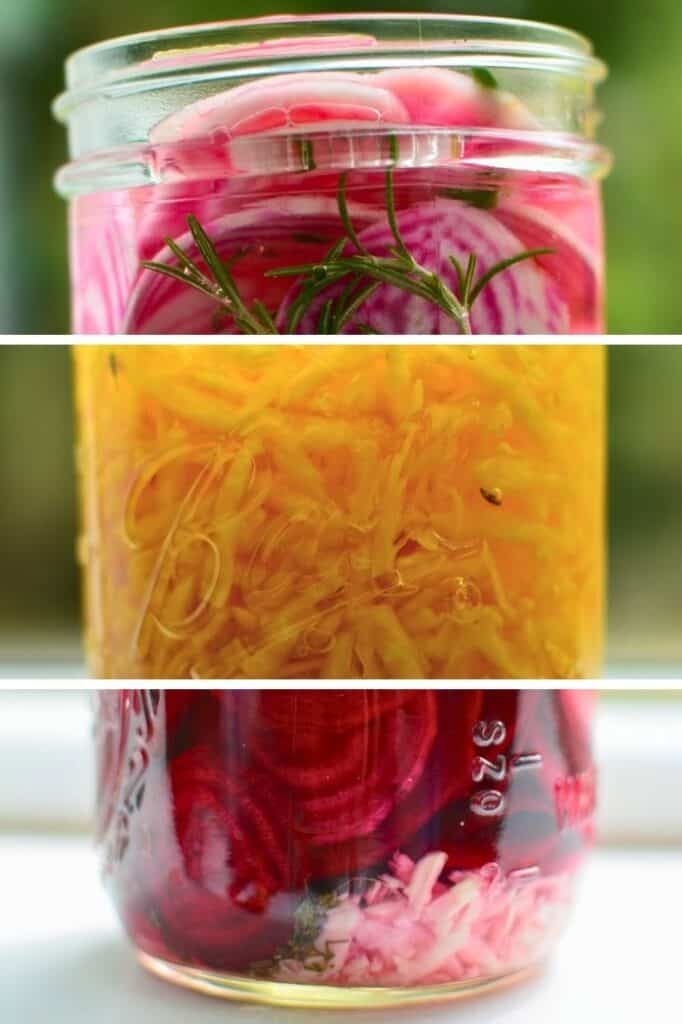
In this guide, I’ll show you how simple it is to make your own batch of tangy, crunchy fermented beets. From health benefits to flavor suggestions, I’ve got you covered.
Did you know that beets have been celebrated for their health benefits for centuries?
From improving blood flow to boosting endurance, these vibrant root vegetables pack a nutritional punch. Inspired by their versatility and goodness, we’re diving into the world of fermented beets, exploring everything from the basics to creative recipes.
Whether you’re a fermentation newbie or a seasoned enthusiast, making your own fermented beets is a delicious adventure.
- Amazing Benefits of Beetroot & Beetroot Juice
- Additional Health Benefits from Fermented Beets
- Possible Side Effects of Consuming Beetroot
- How to Make Fermented Beets
- Recipe Flavor Suggestions
- Tips & Tricks for Successfully Fermenting Beets
- Naturally Fermented Beets Recipe
- Ways to Enjoy Your Fermented Beets
- Other Delectable Ways to Ferment Beets
Beets have been gaining in popularity as a new superfood due to recent studies claiming that beetroot juice can lower blood pressure, increase blood flow and improve athletic performance among many other things.
Maybe it would behoove us to figure out a way to enjoy beets on a regular basis.
Beets come in a variety of colors, shapes, and sizes as witnessed during a recent trip to my local farmer’s market.
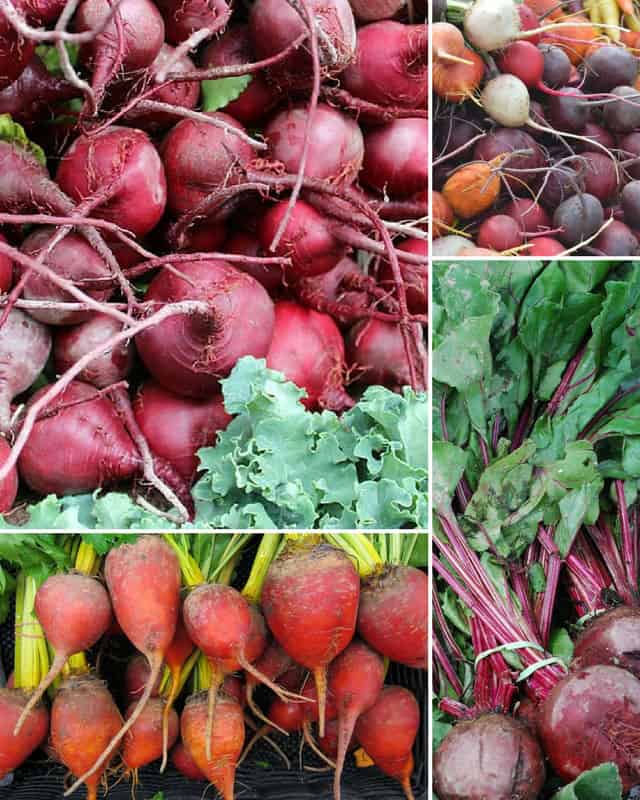
And, like fermented carrot sticks, fermented beets—sliced, diced, shredded, match-sticked, or spiralized—are super-simple to make.
Beets,
Water, and
Salt.
Something fun to flavor them with.
Some help for our support team, millions of Mighty Microbes,
Time.
And, Voila.
You have this!
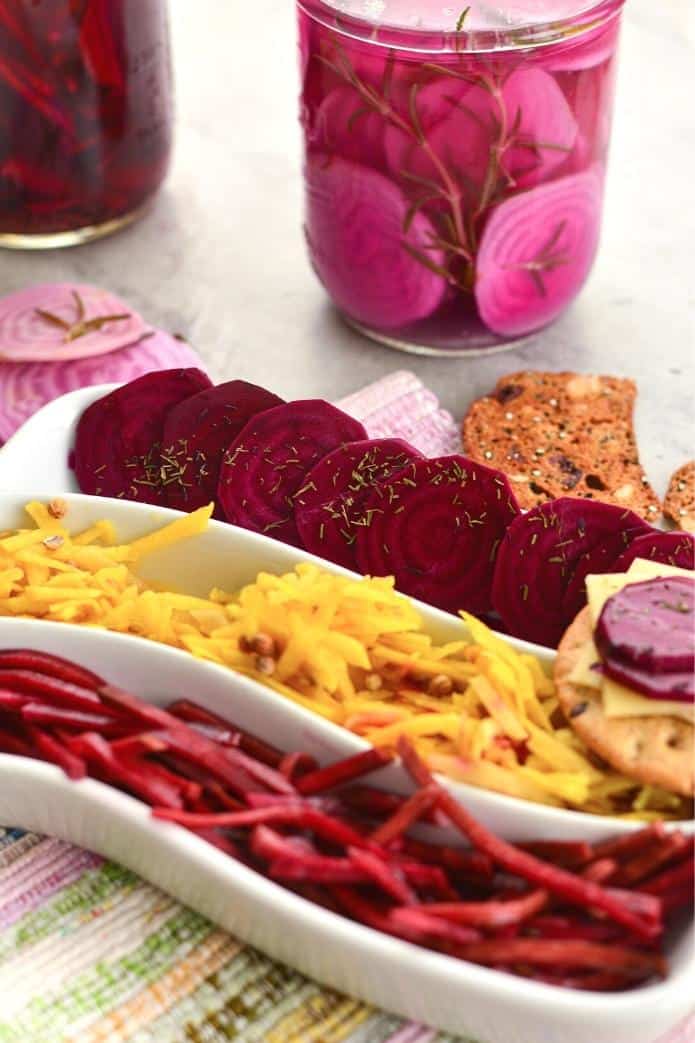
But, first a bit on their benefits.
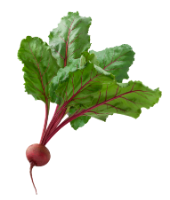
Beetroot juice is one of the richest dietary sources of antioxidants and naturally occurring nitrates. Nitrates (not to be confused with nitrites!) are compounds that improve blood flow throughout the body—including the brain, heart, and muscles.
Amazing Benefits of Beetroot & Beetroot Juice
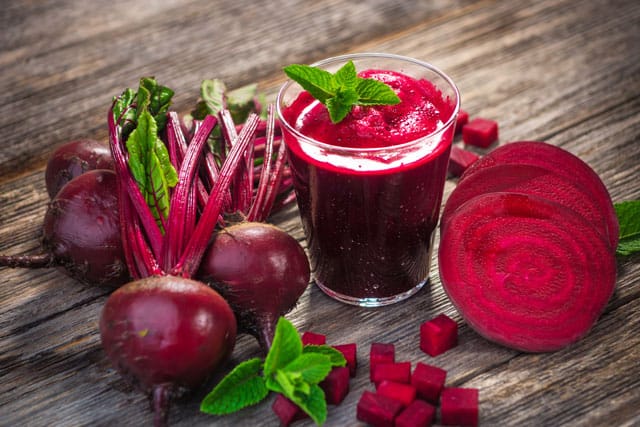
During my research for this article, I stumbled across the website Love Beets. Recipes galore, beet juice, beetroot powder, and more.
Here is a summary of just some of the benefits I read about:
- Beets are a valuable source of nutrients, vitamins, minerals, and fiber.
Beets are an excellent source of magnesium, potassium, and iron along with soluble fiber. They are also rich in vitamins C, A, and B6 and antioxidants. Beets contain an exceptionally high level of folic acid. In a one-cup (250 ml) serving of beets, you’ll find 37% of the recommended daily serving of folate and 11% of the daily recommended serving of Vitamin C. Studies are indicating that nutrients taken through food are more powerful than as an isolated supplement. Eat your beets! - Beets can improve heart health and lower blood pressure.
The potassium in beets works with sodium to keep the volume of blood in circulation steady by flushing excess sodium out of the system and lowering blood pressure. Natural nitrates in beets dilate blood vessels, improve the flow of blood, and lower blood pressure. A 2008 study examined the effects of drinking 2 cups (500 ml) of beetroot juice in healthy individuals and found that blood pressure was significantly lowered. - Beets increase blood flow and combat dementia.
Beets produce nitric oxide, which helps increase blood flow throughout your body, including to your brain. MRIs done on older adults showed that eating a high-nitrate diet that included beet juice, improved blood flow and oxygenation to certain areas of the brain. - Beets boost endurance.
Athletes who drank beet juice mixed with a bit of apple juice before working out had better endurance and lower resting blood pressure. It is thought that this is due to the nitrates found in beets that improve muscle oxygenation by improving improve blood flow to the muscles during exercise and relieving some post-workout muscle aches. - Beets combat constipation.
The high content of fiber in beets helps to prevent constipation and promotes regularity for a healthy digestive tract. - Beets are a great blood builder.
If you suffer from anemia or fatigue, the high iron content in raw beets can be an effective addition to your diet.
Motivated to add beet juice to your diet?
You can forego juicing and use instead some beetroot juice powder or some beetroot root powder.
Beetroot powder made from beet juice is spray-dried from juice extracted from the beets. Beet juice powder dissolves very nicely in water and is fairly pleasant to drink by itself. Look carefully at the ingredients. Some contain all sorts of tasty stuff: sweeteners, fillers, and additives. Expect to pay $20-30 for a 7-ounce (200 g) package. If the price is lower, you’re getting ground beetroot, not dehydrated beet juice.
Red Beet Crystals by Salus. The label states that approximately 5.5 pounds (2.5 kg) were used to produce the 200 grams of crystals. Organic. “These are harvested in special forests in Germany to assure purity.”
This Beet Root Juice Powder is made from 100 percent U.S.-grown organic beets. The beets are juiced, then dried in a way that preserves the nutrient content.
Beetroot root powder is made from ground up & dehydrated beets and includes all the fibrous material in beets. The powder does not dissolve as nicely as a juice-based powder and has a somewhat chalky, grittiness to it and not the clean taste you get from just beetroot juice. India and China seem to be the place where all these beets are grown.
Beet Root Powder by Bulk Supplements. Grown in China, purity and identity testing through a third party within the US.
Organic Beet Root Powder by Naturevibe Organics. Grown in India, USDA Organic, non-GMO.

Beetroot or table beets are from the same family as sugar beets but they are genetically and naturally different. Sugar beets are white in color and are used for extracting sugar for food processors. Sugar cannot be obtained from beets which are mostly red or gold in color.
Additional Health Benefits from Fermented Beets
If you ferment your beets, they are packed with the same goodness as sauerkraut and other fermented vegetables. In addition to having the benefits discussed above, fermented beets:
- Are an excellent source of probiotics.
Similar to those found in yogurt, probiotics produced during fermentation are known to have many health benefits: improved digestion, enhanced immune system, and better brain function to name a few. - Have increased the nutritional value.
Lactic-acid fermentation produces and enhances the levels of enzymes, vitamins, and minerals. - Are easier to digest than raw or cooked vegetables.
Fermentation breaks down hard-to-digest cellulose. - Are safer to eat than raw vegetables.
Raw vegetables can have E.coli on them, but lactic acid produced during fermentation kills off the E.coli bacteria. They can’t survive in the acidic environment of fermentation.

Since the 16th century, beet juice has been used as a natural red dye. In 19th century England, the Victorians used beets to dye their hair.
Possible Side Effects of Consuming Beetroot
Before you go hog wild and start eating beets for breakfast, lunch and dinner, here are a few things to be aware of.
- Red Urine.
An estimated 10-15% of all U.S. adults experience beeturia – a reddening of the urine – after consumption of beets in everyday amounts. This phenomenon is not considered harmful, but it may be a possible indicator of iron deficiency, iron excess, or problems with iron metabolism. If you experience beeturia and have any reason to suspect iron-related problems, consult your healthcare provider. - Gout.
Beets are high in oxalate, which can contribute to gout, a type of arthritis that develops when too much uric acid builds up in the body. - Discolored Stool.
You might find that eating beets relieves constipation, but don’t be alarmed if your stool is pink or red. It’s not blood; and is actually harmless. - Nitrites.
Nitrites can interact with the dietary protein in the stomach to potentially make substances called nitrosamines. The majority of nitrosamines are carcinogenic (cancer-causing) in animals and this is likely to be similar in humans. Research has not been done to show whether taking nitrate-rich vegetable drinks long-term is safe in terms of nitrosamine levels with a high nitrate diet.

An estimated 10-15% of all U.S. adults experience beeturia – a reddening of the urine- after consumption of beets in everyday amounts.
How to Make Fermented Beets
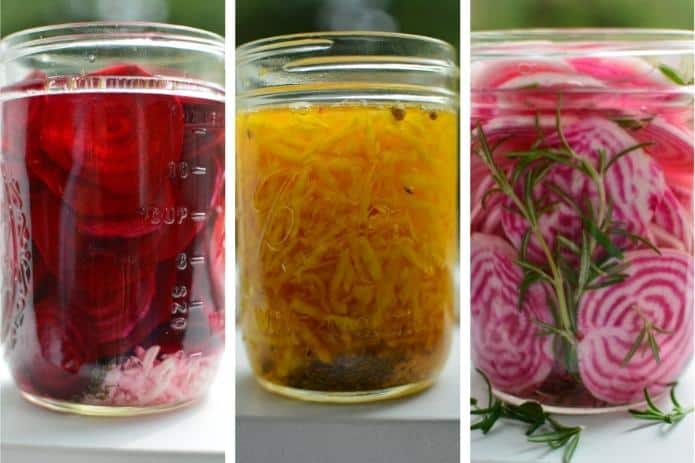
Don’t Use a Brine Chart
My recipes for brine-fermented vegetables are different from most of the other recipes on the internet that rely upon numbers off a brine chart.
Most recipes have you pack your jar with vegetables, mix a salty brine, and then pour the brine into your packed jar.
Results will vary greatly because the amount and weight of the vegetables you packed into the jar vary greatly.
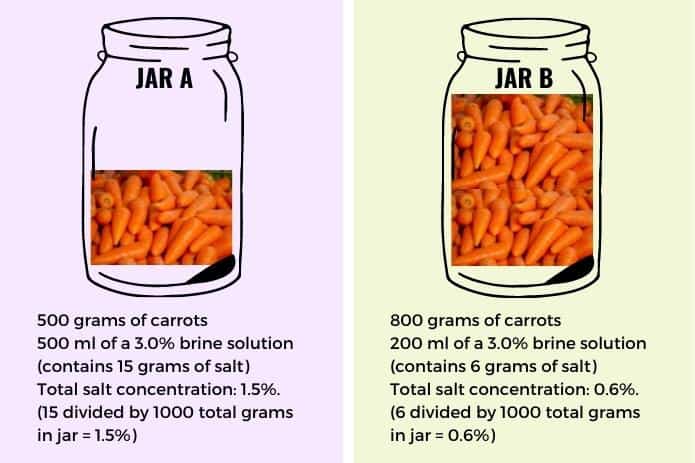
Maybe I packed my jar with 500 grams of carrots, topped with 500 ml of a 3.0% brine containing 15 grams of salt. But, you packed your jar with 800 grams of carrots and topped it with only 200 ml of a 3.0% brine containing only 6 grams of salt.
Neither jar contains a high enough total salt concentration for safe, mold-free fermentation. The right total salt concentration is key for success with brine-fermented vegetables.
As I researched and developed recipes for my In A Pickle! online course, I realized that you can’t ferment crunchy, tangy pickles by just pouring a salty brine into a jar of packed vegetables.
The bacteria responsible for fermentation, need a set salt concentration to create the lactic acid necessary for a safe ferment.
You have to know the weight of both the vegetables and the water in your jar and calculate your salt based on that.
Once you know this weight, you multiply it by the recommended total salt concentration for the vegetables being fermented (2.5% for beets) and then add the correct number of grams of salt to the jar.
Don’t worry, it’s simple to do and I’ll take you through it step by step.
Salt Concentration Chart FREE Download
Use the button below to get your own printable Salt Concentration Chart.
Step-by-Step Recipe Photo Instructions
First, here’s the recipe in pictures followed by suggestions for flavoring your beets, tips for success, and then the official step-by-step recipe.
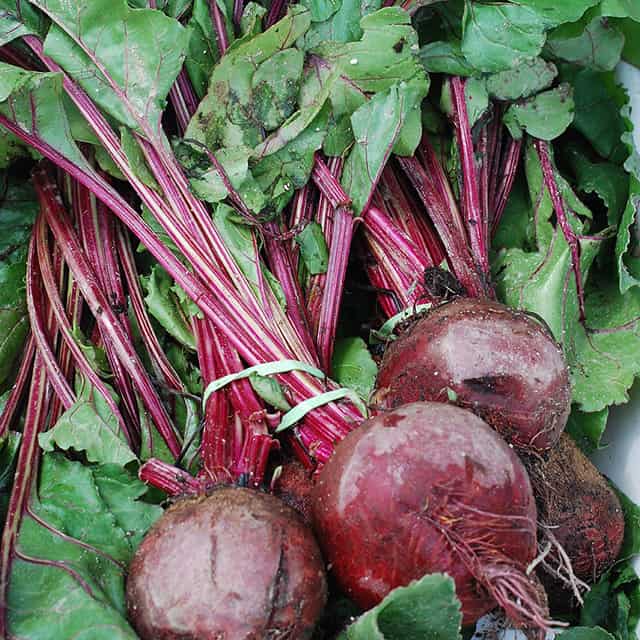
Purchase Fresh Beets
Fresh-picked beets are tender and give the best results. Beets, with greens attached, indicated freshness. Beets that were picked months ago are too tough.
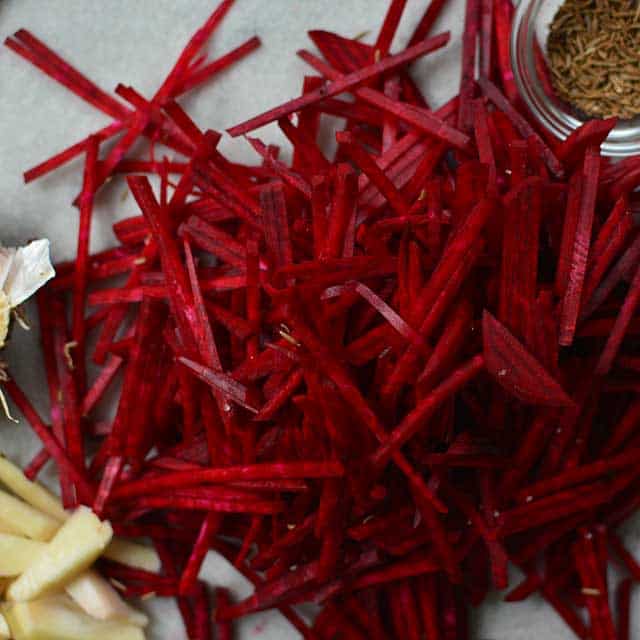
Prepare Flavoring Item & Beets
One of my favorites is garlic and caraway. In the recipe, I give several suggestions.
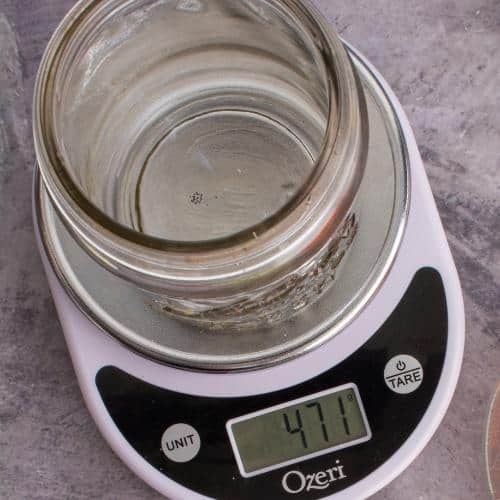
Weigh Jar
Use a digital scale to obtain the weight—tare—of your jar (471 grams, for example). Write this number down.
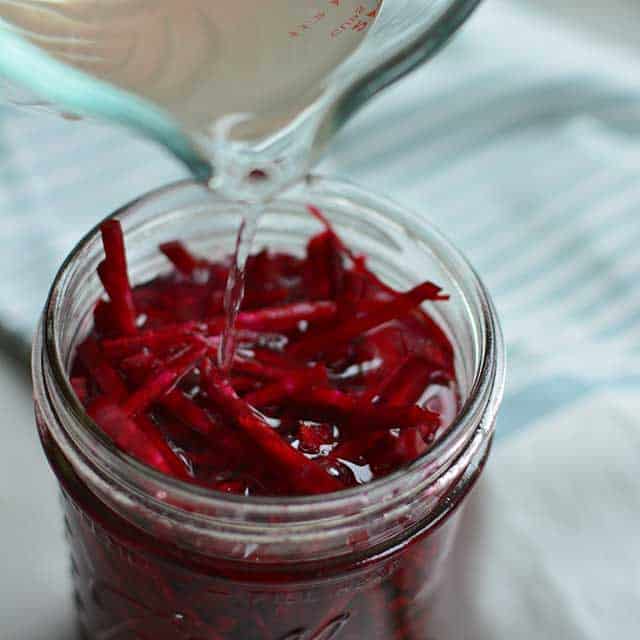
Pack Jar & Top with Water
Pack jar with beets, top with water, stopping 1-2 inches below the threads of the jar. Set aside.
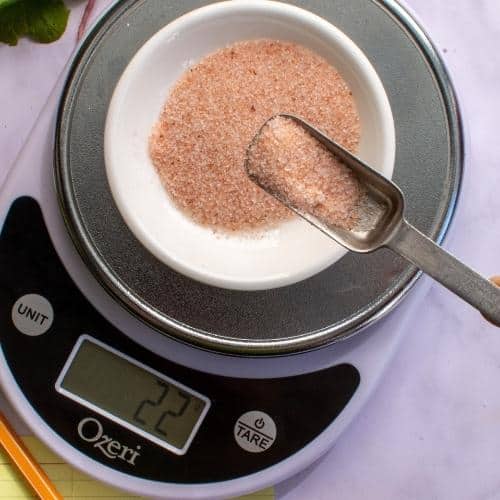
Calculate & Add Correct Grams of Salt
Weigh your packed jar, then subtract the jar weight from the total weight (1322 – 471 = 851, for example).
Multiply the weight of the contents in your jar by 0.025 (851 x. 0.025 = 21, for example).
Tare a small dish and weigh the correct grams of salt (21 grams, for example).
Add this salt to your jar of beets. Screw on the canning lid and rim that came with your jar and shake for one minute to dissolve the salt.
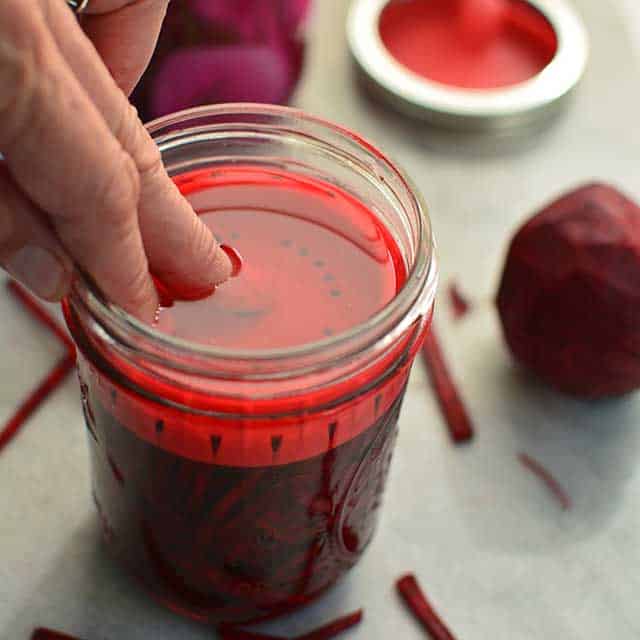
Submerge & Seal
Add a fermentation weight to keep the vegetables submerged under the brine.
Close the jar either with an airlock or with a lid left loose enough to allow CO2 to escape.
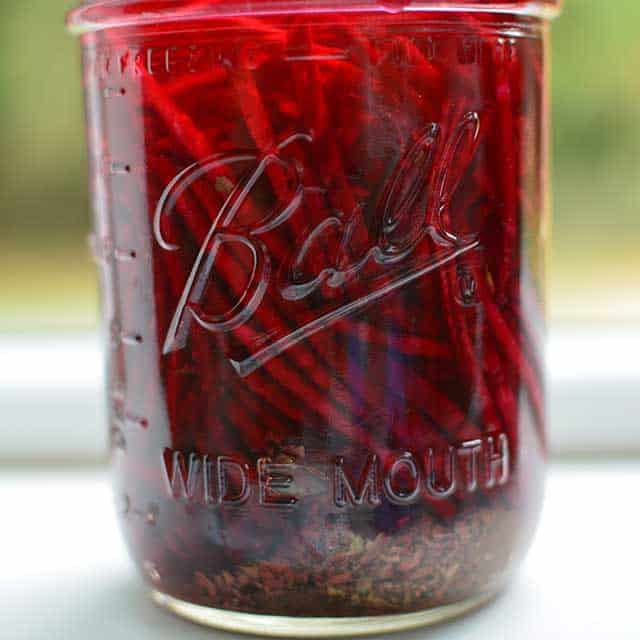
Ferment
Ferment within the ideal temperature range (65-72F, 18-22C) for 2 weeks.
Feel free to taste on Day 7, then daily until the flavors are to your liking.
Colors will fade. The brine will get cloudy.
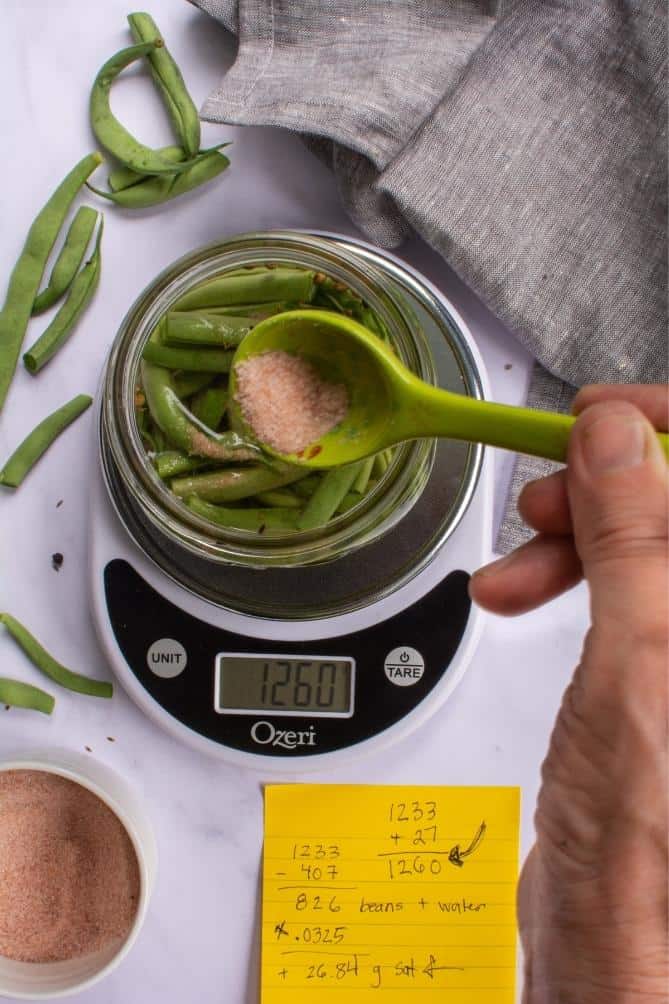
Get ready to be surprised by the wide variety of pickles you can safely & easily preserve at home.
Learn the Perfect Pickle Process in my online program and “grow” your own probiotic-rich superfoods. YUM!
Recipe Flavor Suggestions
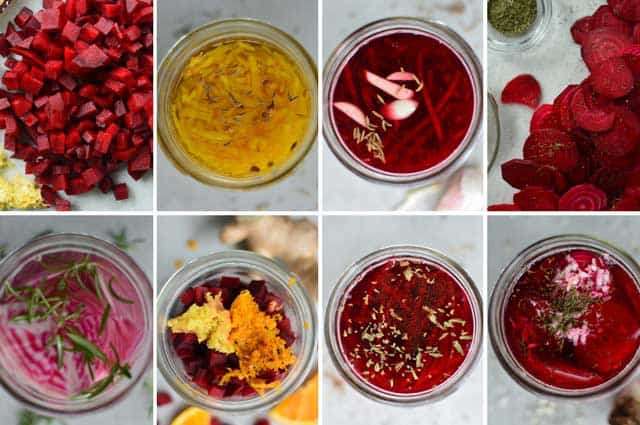
You can effortlessly infuse beets with a variety of flavors by the addition of some simple seasonings: garlic, dill, ginger, rosemary, cumin, or even horseradish.
There is one ingredient you will not see in my recipe:
Vinegar.
And, one step missing:
Cooking, canning, or heat processing in any way.
Before refrigeration, fermentation is how cultures around the world preserved their harvest to enjoy during the upcoming months of winter.
The natural bacteria present on vegetables create lactic acid to give them a sour tang, lower their pH to levels at which pathogenic bacteria can’t survive, and infuse these living foods with a wide range of flavors.
Here are six ways to infuse your fermented beets.
1. Horseradish Fermented Beets
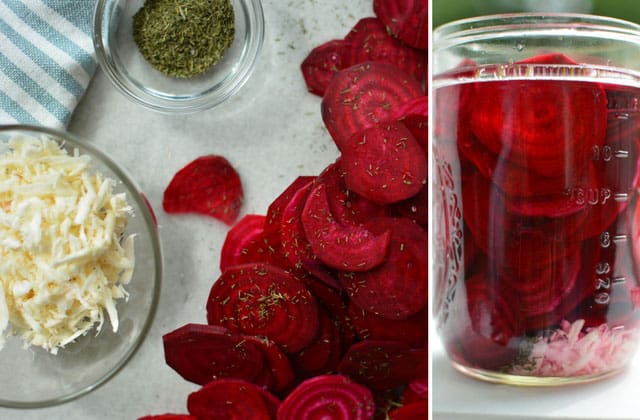
For Horseradish Fermented Beets, place 1-2 tablespoons of peeled and grated horseradish root and 1 teaspoon of dried dill (1 tablespoon fresh) in your jar. Be careful of volatile oils when grating horseradish.
2. Passion Pink Fermented Beets
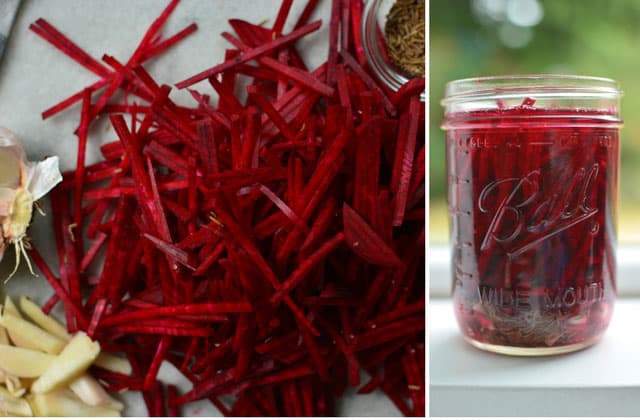
For Passion Pink Fermented Beets, place 1-2 slivered garlic cloves and 1 teaspoon of caraway seeds in your jar.
3. Cardamom Fermented Beets
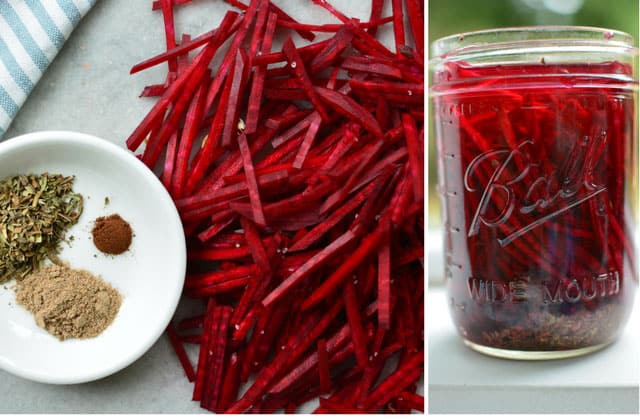
For Cardamom Fermented Beets, place 1 teaspoon dried tarragon (1 tablespoon fresh), ½ teaspoon cardamom powder, and ¼ teaspoon ground cloves in your jar.
4. Powered-by-Turmeric Fermented Beets
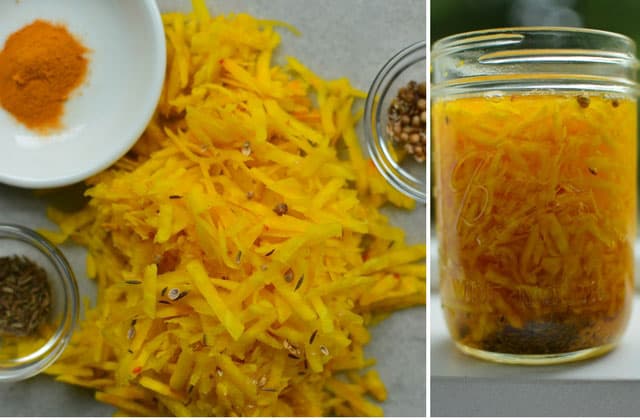
For Powered-by-Turmeric Fermented Beets, place ½ teaspoon turmeric powder, ½ teaspoon coriander seeds, and ½ teaspoon cumin seeds in your jar.
5. Rosemary Fermented Beets
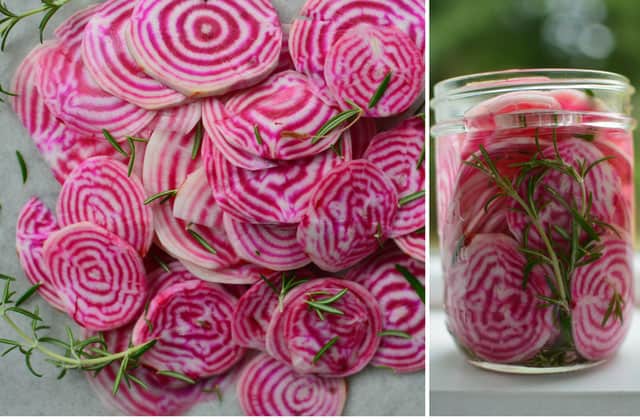
For Rosemary Fermented Beets, place 1 tablespoon of roughly chopped, fresh rosemary leaves in your jar.
6. Ginger Sparkle Fermented Beets
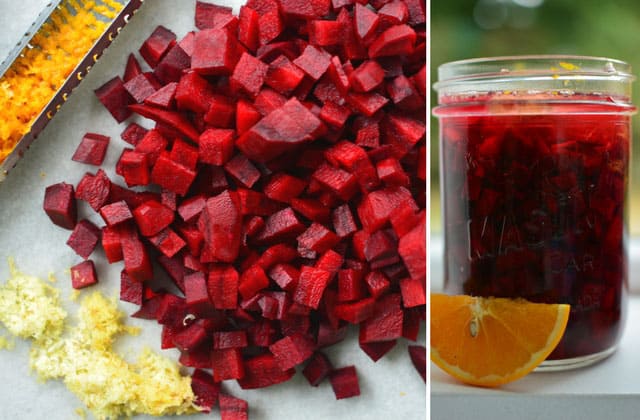
For Ginger Sparkle Fermented Beets, place 1 tablespoon freshly grated ginger and just a bit of orange zest in your jar, just a ¼ of the orange. Too much zest can impart a bitter taste and overpower the ginger.
Tips & Tricks for Successfully Fermenting Beets
With a bit of experience and a few batches under your belt, you’ll be able to fine-tune the fermentation process to your liking. Here are a few tips to keep in mind as you ferment your first batch:
- Choose small or medium beets that feel firm and heavy for their size and have smooth skin. Fresh beets with their tops still on are best.
You cannot create tender fermented beets if you start with tough, dry, fibrous beets. Look for blemish-free beets without soft, wet areas or flecks of mold. - Your best bet for final colors is to ferment red beets.
Striped beets lose some of their colors; golden beets fade.
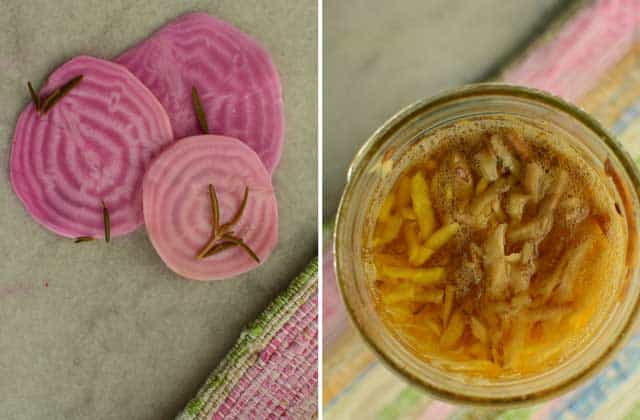
- Think slender when slicing your beets.
To expose more of their cells and have a more tender finished product, you want to think thin: fairly thin slices, a nice julienne cut (my favorite), extra skinny matchsticks, small cubes, or a coarse grate.
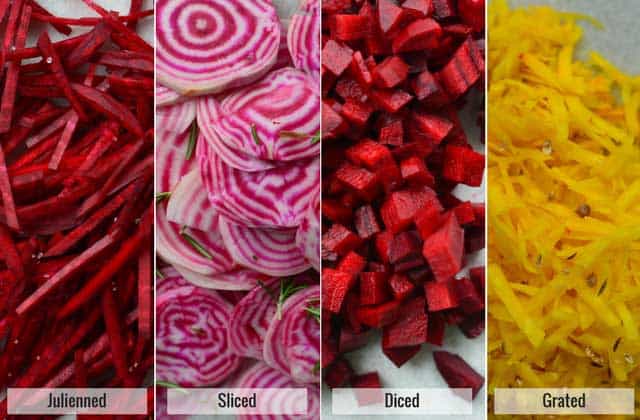
- Use a food processor, mandoline, or spiralizer.
These handy gadgets give finer cuts, making for a tender finished product. Beets are easy to cut with a mandoline or spiralizer if they are tender and young; tough, hard beets that have been stored for months can be difficult to draw across the blade, which is when accidents happen.
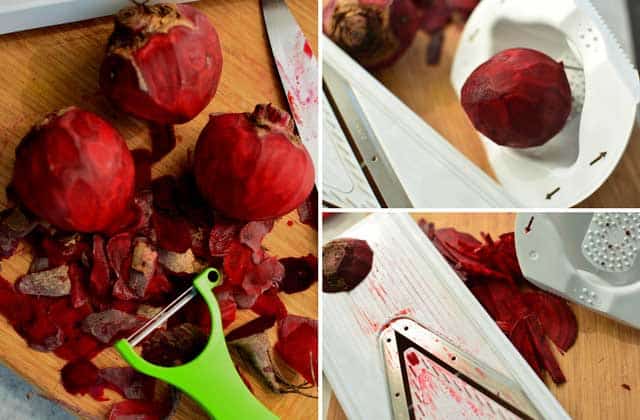
- Do not cook your beets.
Some recipes for naturally fermented beets call for cooking them first. Don’t! You will kill off the entire army of Mighty Microbes and instead of fermenting, your beets will become a slimy, smelly mess. - My favorite salt for fermentation is Himalayan Pink.
I talk about the best salt for fermentation here, here. In short, use non-iodized salt. - Below the brine.
For worry-free fermentation, it is best to use some sort of weight to hold the beets below the brine. This will help reduce browning, a common occurrence with beets.
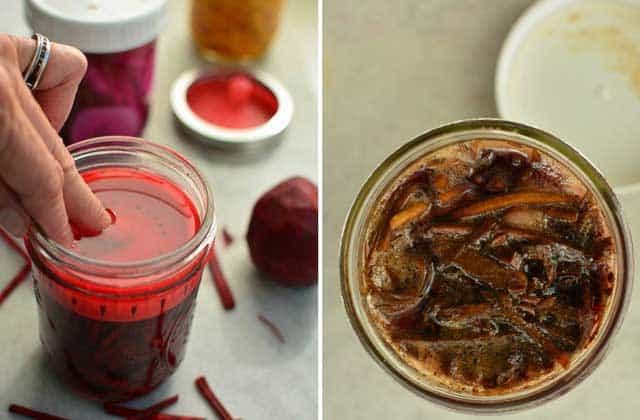
- No airlock
Airlocks allow excess gases to escape. If you don’t have an airlock and you want to be super safe, burp your jar once daily during the first 3 days.
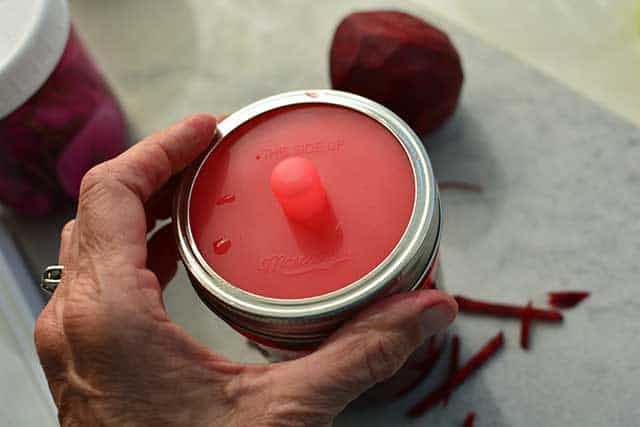
- Dark scum.
You’ll often see brown scum on the surface of your ferment. It is perfectly normal and comes from the oxidized colors of the beets. Remove what you can. - Syrupy brine.
Beets have the highest sugar content of any vegetable so don’t be surprised if the brine of your ferment is thick and syrupy. You can cut the sugar levels of your ferment by mixing in turnips, radishes, or jicama—about half beet, half turnips, radishes, and/or jicama. Note: Using jicama in your ferment is also a great way to ensure you are eating prebiotics. - DO drink leftover fermented brine, or use it to make salad dressings.

The biggest beet in the world was grown by a Dutchman. It weighed over 156 pounds.
The Five Tools I Grab Every Time I Ferment Something

Beets are high in fiber, which helps with satiety and regularity.
Naturally Fermented Beets Recipe
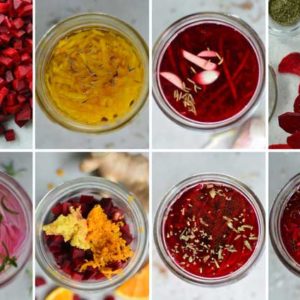
Naturally Fermented Beets
INGREDIENTS
- 2-3 beets,, medium-sized (baseball sized)
- FLAVORING Choose from ONE of the following:
- 1-2 tablespoons of peeled and grated horseradish root, and 1 teaspoon of dried dill (1 tablespoon fresh), or
- 1-2 slivered garlic cloves and 1 teaspoon caraway seeds, or
- 1 teaspoons dried tarragon (1 tablespoon fresh), ½ teaspoon cardamom powder and ¼ teaspoon ground cloves, or
- ½ teaspoon turmeric powder, ½ teaspoon coriander seeds and ½ teaspoon cumin seeds , or
- 1 tablespoon roughly chopped, fresh rosemary , or
- 1 tablespoon freshly grated ginger and just a bit of orange zest in your jar, just a ¼ of the orange
- Iodine-free salt (fine-grain)
- Non-chlorinated water
INSTRUCTIONS
- PREP FLAVORING ITEM.Prep what you'll be using to flavor your beets.
- PREP BEETS.Peel beets. Then, cut into shape desired: sliced, julienned, grated, cubed. Note: Do not cook beets as it kills off the bacteria necesary for fermentation.
- WEIGH JAR.Use a digital scale to obtain the weight—tare—of your jar (471 grams, for example). Write this number down.
- PACK JAR.Place what you'll be using to flavor your beets in the bottom of your jar then pack beets into the jar leaving one to two inches of head space.
- TOP WITH WATER.Pour water over beets letting it percolate down.
- CALCULATE & ADD 2.5% SALT.Weigh your packed jar. The number on the scale is the weight of the jar, plus the weight of the vegetables and the water (1322 grams, for example).Subtract the jar weight from the total weight (1322 – 471 = 851, for example).Multiply the weight of the contents in your jar by 0.025 (851 x. 0.025 = 21, for example).Tare a small dish and weigh the correct grams of salt (21 grams, for example).Add this salt to your jar of beets.
- DISSOLVE SALT.Screw on a standard canning jar lid and rim and tightly secure. Shake the jar for a couple of minutes to dissolve the salt.Remove lid.
- SUBMERGE & SEAL.Add a fermentation weight to keep the vegetables submerged under the brine. Close the jar either with an airlock or with a lid left loose enough to allow CO2 to escape.
- FERMENT.Label with recipe name, date, and salt concentration. Place in a shallow bowl on your kitchen counter, out of direct sunlight to ferment until active bubbling stops, usually, 7-14 days depending upon the temperature of your room.Feel free to taste them along the way. The beets are ready when bubbles have stopped rising to the surface, there is a slightly sour aroma and the beets taste tangy.
- STORE.Add the fermentation length to your label and put in the refrigerator. Your fermented beets may be eaten immediately, but will increase in flavor with time and will keep for up to a year, though they lose color as the months go on.
- ENJOY!Now for the best part. Use your fermented beets to top a salad, add to your cheese and cracker platter, alongside a meal, or straight from the jar. Don't forget to drink the brine. I sip a bit each time I use my fermented beets.
Notes and Tips
- Fresh beets with their tops still on are best.
- Use a food processor, mandoline, or spiralizer to prepare your beets.
The use of these handy gadgets results in finer cuts, making for a tender finished product. - My favorite salt for fermentation is Himalayan Pink. I talk about the best salt for fermentation here, here. In short, use non-iodized salt.
- Use a 2.5% salt concentration.
- For worry-free fermentation, it is best to use some sort of weight to hold the beets below the brine. This will help reduce browning, a common occurrence with beets.
- Airlocks allow excess gases to escape. If you don’t have an airlock and want to be super safe, burp your jar once daily during the first 3 days.
- When you pop the lid to check and taste your jar of fermenting beets, you might see brown scum on the surface. It is perfectly normal and comes from the oxidized colors of the beets. Just remove what you can.
- Beets have the highest sugar content of any vegetable so don’t be surprised if the brine of your ferment is thick and syrupy. Feel free to cut the sugar levels of your ferment by adding in turnips, radishes, or jicama.
- Ideal fermentation temperature is 65-70°F (18-21°C) is ideal. If it is super hot, shorten; cold, lengthen.
- DO drink leftover fermented brine, or use it to make salad dressings.
Ways to Enjoy Your Fermented Beets
Nibble on them straight out of the jar.
Enjoy them alongside cottage cheese.
Add them to sandwiches.
Serve them with cheese and bread for a quick lunch or snack.
How about this Antipasti Platter from Love Beets?
Add them to salads.
And, when the last beet stick or slice has been consumed, drink that liquid. After all, it’s Beet Kvass, a fermented tonic, and is full of good nutrition. And, with all those flavoring ingredients, it’s extra tasty.

In ancient times, the root part was not used for cooking but instead as a medicine for treating painful disorders at that time, like headaches and toothaches.
Other Delectable Ways to Ferment Beets
Fermented beets may not appeal to everyone. Here are three other ways to ferment beets: Beets Kvass, Beet Relish, and beet-infused Sauerkraut.
Beet Kvass
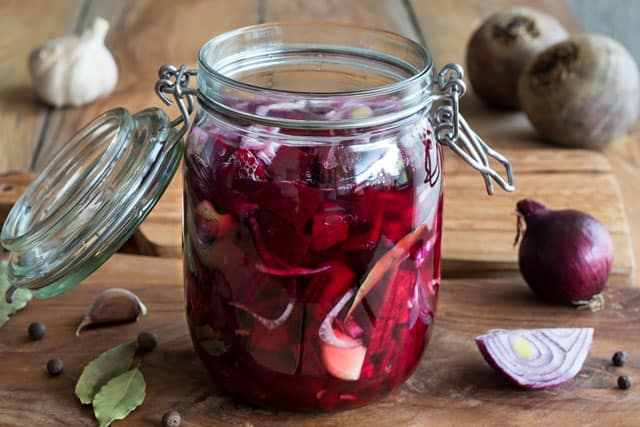
Beet Kvass is a tonic that is fermented much like beets. However, you use fewer beets, generally leave it to ferment longer, and drink just the brine that has been infused with the flavor and nutrients from the beets.
“This drink is valuable for its medicinal qualities and as a digestive aid. Beets are just loaded with nutrients. One 4-ounce glass, morning and night, is an excellent blood tonic, promotes regularity, aids digestion, alkalizes the blood, cleanses the liver, and is a good treatment for a kidney stone and other ailments.” – Sally Fallon, Nourishing Traditions.
Beet Kvass is also a good option for those of you who have gut issues such that you can’t tolerate the fiber in sauerkraut at this time. It is another way to make Gut Shots, a drink made popular by Farmhouse Culture.
I offer an online Beet Kvass & Kanji Masterclass course where I teach about these two wonderful digestive tonics and demonstrate how to ferment them.
Beet Relish
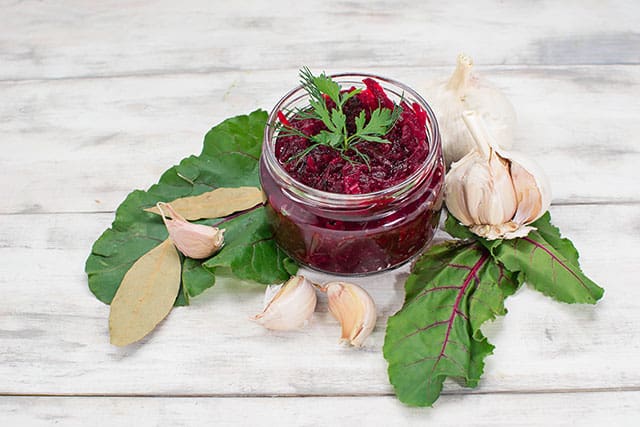
Relish is a beautiful way to enjoy your beets. Simple to prepare and a great accompaniment to most meals.
Probiotic Apple & Beetroot Relish
This recipe is half shredded beets and half shredded apples to cut the strong, earthy flavors of beets.
“Beetroot relish – savory, sweet and spiced with cloves and star anise – nuzzles its way onto our supper plates every winter. A near-perfect side to pan-fried pork chops seasoned with sage or to classic roast beef, beetroot relish provides an intensity of flavor coupled with nourishing micronutrients including vitamins, minerals, and antioxidants.” – Jenny
Probiotic Apple & Beetroot Relish by Jenny of Nourished Kitchen
Fermented Horseradish Beet Relish
I love this combination though I could not find a recipe without starters. I would omit the whey and make sure to use 2% salt by weight. All should be fine.
During fermentation horseradish loses much of its heat – through the escape of volatile oils – so don’t expect this to have the same kick as commercially prepared horseradish.
Fermented Horseradish Beet Relish by Hayley of Health Starts in the Kitchen
Beet-Infused Sauerkraut
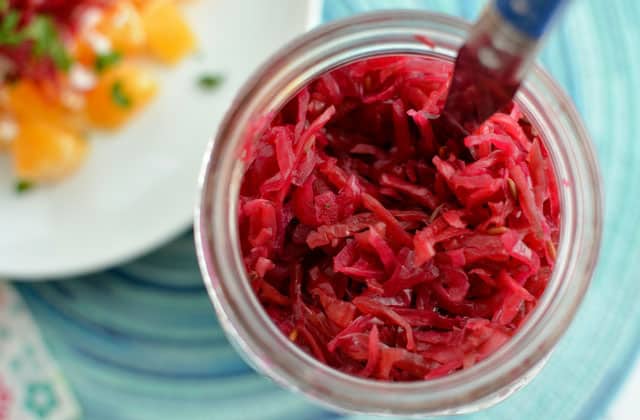
I love to include one or two shredded beets in my sauerkraut recipes. It is a way to get some of the nutrition from the beets but not with as strong a flavor as eating fermented beets on their own.
Passion Pink Sauerkraut
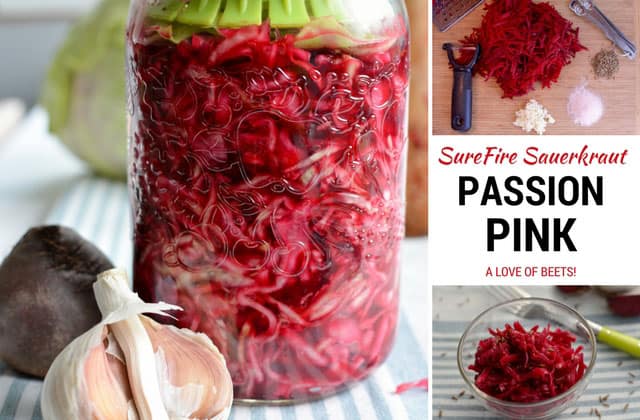
This recipe of mine is flavored with garlic and caraway seeds.
Beet Ginger Sauerkraut
This recipe is found in my curated recipe roundup: 35 Mouthwatering Sauerkraut Recipes and is flavored with… you guessed it, ginger.
Ginger Beet Sauerkraut
This recipe is also found in my curated recipe roundup: 35 Mouthwatering Sauerkraut Recipes and is flavored with ginger and cardamom.

One of the earliest known benefits of the red beet is its use as an aphrodisiac during Roman times. And it wasn’t all folklore, as it has been found to contain high amounts of boron, which is directly related to the production of human sex hormones.
Salt Concentration Chart FREE Download
Use the button below to get your own printable Salt Concentration Chart.
References & Sources
11 Amazing Benefits of Beets by Organic Facts
15 Health Benefits of Beets, According to Science (+8 Delicious Beetroot Recipes) by Jen Reviews
Beets by the World’s Healthiest Foods
How Beets Help Blood Flow, Energy Generation, and Weight Loss
Love Beets
Have you ever fermented beets? Do you have a favorite recipe?
Share your thoughts in the Comments section.

Last update on 2024-07-26 / Affiliate links / Images from Amazon Product Advertising API



 This post may contain affiliate links which won’t change your price but will share some commission.
This post may contain affiliate links which won’t change your price but will share some commission.



